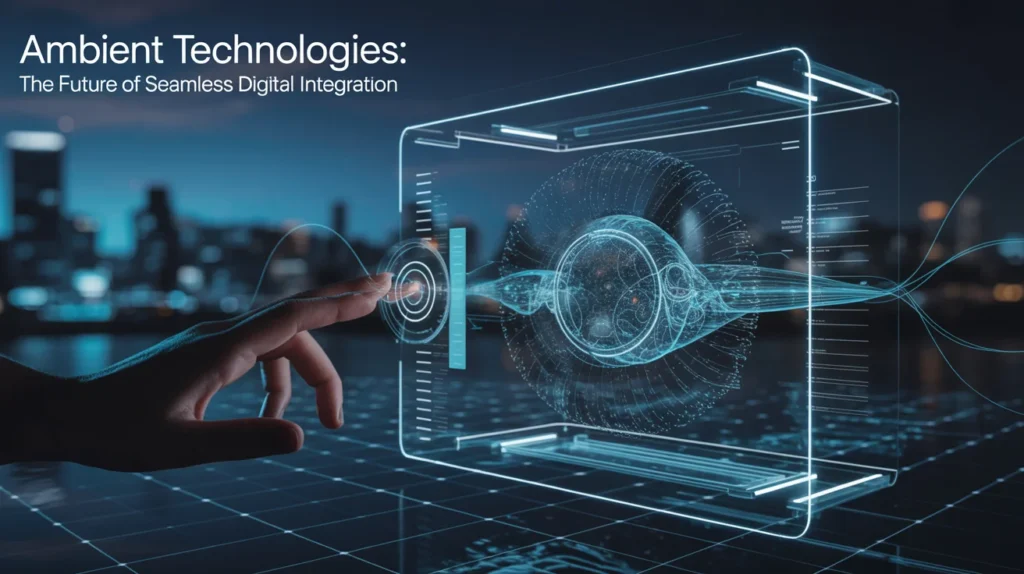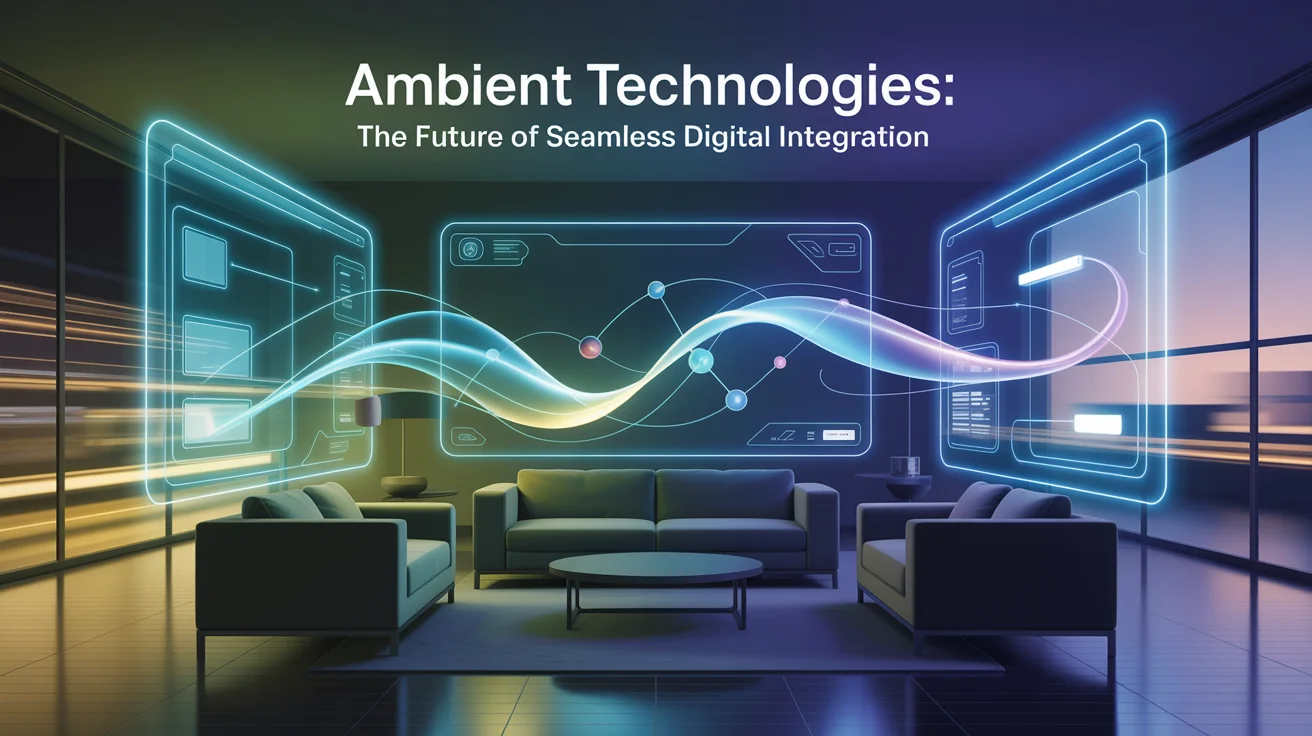In today’s fast-paced digital era, ambient technologies are quietly transforming how we interact with the world.
These are smart, context-aware systems that work silently in the background, making life easier, faster, and more connected.
From smart homes to healthcare innovations, these technologies are shaping a new era of intelligent automation.
As these systems grow more advanced, they blend into our environment, becoming almost invisible. Yet, their impact is massive.
Let’s explore how ambient technologies are redefining our daily lives, their benefits, challenges, and future potential.
What Are Ambient Technologies?
Ambient technologies refer to digital systems that operate subtly in the background, understanding and reacting to user needs without direct input. They use sensors, AI, machine learning, and data analysis to provide a seamless experience.
These technologies don’t require active interaction. Instead, they anticipate needs by collecting data from the environment and adapting accordingly. This creates an intelligent ecosystem that works with minimal human effort.
They are often used in:
- Smart homes for automation and energy saving
- Healthcare to monitor patients remotely
- Offices to enhance productivity and comfort
How Ambient Technologies Work
The core of ambient technology is context awareness. Devices continuously gather information from their surroundings and respond intelligently. They function smoothly using a combination of hardware (like sensors) and software (like AI algorithms).
These systems integrate across platforms and devices, enabling fluid communication. This interconnectedness ensures that the technology works harmoniously without disrupting the user experience.
Their functionality can be explained through:
- Perception: Understanding the environment via sensors
- Interpretation: Analyzing user behavior through AI
- Action: Responding with personalized automation
Benefits of Ambient Technologies in Daily Life

Ambient technologies improve our lives in many ways. They make systems smarter, environments more responsive, and services more efficient. As a result, users enjoy more convenience, safety, and personalization.
Let’s break down the advantages into different sectors for clarity:
Homes: Smart thermostats, lights, and voice assistants make homes energy-efficient and comfortable.
Healthcare: Wearable devices track heart rates, sleep patterns, and blood pressure without manual input.
Workspaces: AI-powered lighting and climate control boost focus and reduce fatigue.
Here are some notable benefits:
- Increased energy efficiency
- Better personal safety and health monitoring
- Real-time decision-making support
- Minimal manual effort for routine tasks
- Personalized and adaptive environments
Challenges Facing Ambient Technologies
Despite the benefits, there are still challenges that need to be addressed. These hurdles can slow down the adoption of ambient technology, especially in sensitive sectors like healthcare and data management.
The biggest concern is privacy. Since these systems constantly collect data, they raise issues about surveillance and personal security. Moreover, integrating such technology into existing infrastructure can be costly and complex.
Common challenges include:
- Data privacy and user consent
- High installation and maintenance costs
- Limited interoperability between different platforms
- Risk of over-reliance on automation
Applications of Ambient Technologies in Modern Systems
Ambient technologies are transforming industries by making systems more responsive, personalized, and efficient. Their silent presence in the background helps automate tasks, reduce errors, and deliver real-time insights. These innovations are actively reshaping how businesses and individuals operate.
In education, ambient systems adapt content based on student engagement and learning speed. Interactive whiteboards, bright projectors, and learning analytics platforms use data to personalize lessons, improving both teaching and retention. The result is a more dynamic, learner-centered environment.
Ambient technologies are embedded in intelligent traffic systems, vehicles, and public transit in transportation. Real-time monitoring helps reduce congestion, improve safety, and increase fuel efficiency. Cars can now adjust speed based on traffic, weather, and driver behavior, creating a smoother, smarter travel experience.
How Ambient Intelligence Enhances User Experience
Ambient intelligence, a significant component of ambient technologies, is focused on user-centric design. It ensures that devices respond intuitively to human behavior without requiring conscious input.
This leads to smoother and faster experiences that reduce stress and boost satisfaction. Users don’t need to press buttons or issue commands; the system simply “knows” what’s needed.
Such enhancements are visible in:
- Intelligent voice assistants like Alexa and Siri
- AI-driven recommendation engines on Netflix or Spotify
- Intelligent lighting that adapts to the time of day and user preference
Future Trends in Ambient Technologies
The future of ambient technologies is set to be deeply integrated into everyday life. As AI, IoT, and 5G evolve, devices will become even more intuitive and responsive. Users will experience faster, more personalized services without needing to interact directly with devices.
These systems will predict human behavior using data from various sources. This means innovative environments—like homes, hospitals, and offices—will adapt automatically. The goal is to create spaces that think and act on behalf of the user.
We will also see a rise in ethical and secure frameworks to support these technologies. Transparent data use, user control, and fairness will become essential. As innovation grows, responsibility must grow with it.
Why Businesses Should Embrace Ambient Technologies
Integrating ambient technology can offer businesses a strategic advantage. It boosts operational efficiency and enhances customer satisfaction through personalized service. Companies that adapt early can streamline costs and stand out in competitive markets.
The technology also supports data-driven decisions, helping businesses more effectively understand user behavior and market trends. This insight allows for more targeted marketing and service delivery.
Significant business benefits include:
- Enhanced customer loyalty
- Reduced operational costs
- Predictive maintenance and automation
- Smart supply chain management
Environmental Impact of Ambient Technologies
Ambient technologies are playing a quiet yet powerful role in environmental conservation. Their ability to automate and optimize energy usage makes them essential tools in the global fight against climate change. These systems work in the background, reducing human error and resource waste.
Intelligent systems like adaptive lighting, automated climate control, and sensor-based appliances help minimize unnecessary energy use. In commercial buildings, such systems significantly cut down electricity consumption, while in agriculture, they help manage irrigation more efficiently. This translates into real-world benefits for both the environment and economic sustainability.
Moreover, ambient technologies can contribute to waste reduction by monitoring usage patterns and predicting maintenance needs. This avoids overconsumption and prevents the disposal of functional items. As developers continue to focus on eco-friendly design, these innovations are expected to lead the way in sustainable tech.
The Road Ahead: Balancing Innovation with Ethics
Ambient technologies have the power to transform societies, but they must be used wisely. Balancing innovation with privacy, fairness, and accessibility is key. Governments, developers, and users all have roles to play in setting the proper standards.
Future development must be guided by ethical frameworks and transparent design. Only then can we fully enjoy the benefits without compromising on fundamental rights.
Conclusion:
Ambient technologies are not just a trend; they’re a revolutionary step toward a smarter, more connected world. They promise convenience, efficiency, and improved quality of life.
However, thoughtful implementation is vital to balance innovation with privacy and inclusivity. As technology continues to advance, ambient systems will become an invisible yet powerful part of our everyday lives.
Frequently Asked Questions:
Q1: Are ambient technologies the same as innovative technologies?
Not exactly. While innovative technologies require some input, ambient technologies work silently in the background using contextual awareness.
Q2: Is my privacy at risk with ambient systems?
Privacy is a significant concern. Always use systems from trusted providers and review data permissions.
Q3: Can ambient technology help disabled users?
Yes, it can offer hands-free control, voice-activated services, and personalized accessibility features.
Q4: What’s the future of ambient tech in healthcare?
It includes remote patient monitoring, predictive diagnostics, and AI-assisted therapy tools.




